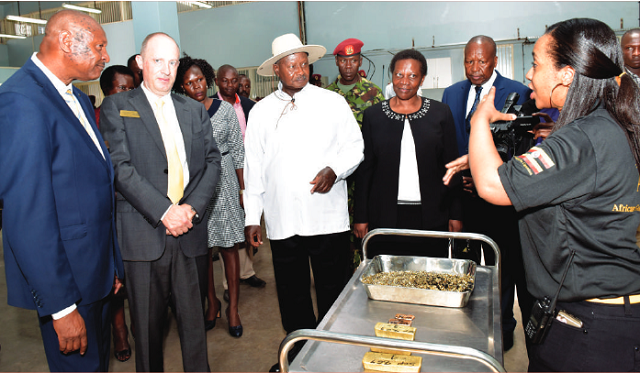
New $20mn firm welcomed but analysts say government must strengthen legal and monitoring framework of minerals sector
President Yoweri Museveni’s launch of a $20 million African Gold Refinery Ltd (AGR) – the first in East and Central Africa – in Entebbe on Feb.20 was a bold step welcomed by sector players as it could increase revenues. Analysts following events in the gold industry, however, fault Museveni for failing to show commitment to regulate a sector competing for the number one position as an export earner. They want firm regulations to determine who does what, where and when. Most of the gold mining in Uganda is still done by small-scale, disorganised artisans operating under a loosely implemented Mining Act of 2003.
Another area of concern is that nobody, including government officials in the minerals sector, appears sure of how much gold Uganda is endowed with and where the deposits are. Instead, there are reports of rampant smuggling of the mineral and heavy security deployments in gold mining areas.
Days before Museveni launched the refinery, Adam Mugume, the executive director for research at the national central bank which collects such statistics told journalists that gold exports had been the main trigger in a 1% rise in the country’s exports for 2016.
“Gold exports in 2016 were US$336 million almost the same as coffee which recorded $340 million,” he said at a Stanbic Bank conference on Feb. 13 in Kampala, “But I don’t know where this gold came from.”
Figures obtained by The Independent from the research department at the Uganda Revenue Authority (URA) are not specific to gold given that a lot of it (gold) was being exported as semi-manufactured and plated with other minerals like silver, platinum, tanzanite and others.
For the period of five financial years (FY 2011/2012 – 2015/2016) data analysis shows that the country exported gold (plated with other metals) valued at close to Shs 800 billion only with a net weight of 16, 368 kgs.
Alain Goetz the chief executive officer of the AGR said in a notice dated Feb. 21 that, the refinery – which he owns 100% – in 2015 alone, processed 1.2 tons of gold, generated Shs1.8 billion in government revenue, employed 75 Ugandan staff at all levels of the business in addition to vital transfer of skills and the major inward investment of over US$23 million.
These numbers paint a positive picture about a previously neglected sector given that in 1994 the country only managed to produce 225 kilograms of gold but Goetz’s figure is much lower than the 7 tons produced in 2000.
The rise in gold exports in 2016, according to government officials was because of the value being added to the gold by the new AGR. Richard Kaijuka, the chairman of AGR, said the company was built to boost value addition as opposed to watching much of the activity being centred on exploration.
Other officials say the refinery accounts for at least 90% of the gold that was exported out of the country in 2016 and part of the second half of the year before (2015).
Sources of most of the gold in Uganda remain largely unknown. But some of the earliest gold discoveries include Mubende (central), Kanungu, Buhweju and Kigezi (West), Busia (East) and Karamoja (northeast) district among others while some of the early mines that were established in the country were the Busitema gold mine and the Kisita gold mine.
Analysts say most areas have not been properly explored for purposes of commercial mining which leaves most gold rich areas to artisans who use traditional methods to mine the precious mineral.
 The Independent Uganda: You get the Truth we Pay the Price
The Independent Uganda: You get the Truth we Pay the Price



